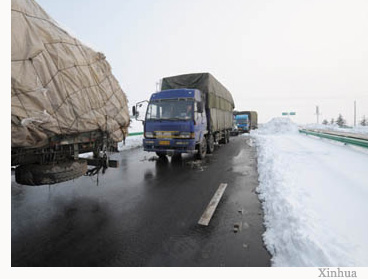China struggles to recover from worst winter storm in 50 years
By Andy Scott
 SHANGHAI, Jan. 29 – The biggest winter storm to hit many parts of Eastern China in 50 years brought down buildings, closed train stations and left millions stranded throughout the country just days ahead of the biggest holiday season.
SHANGHAI, Jan. 29 – The biggest winter storm to hit many parts of Eastern China in 50 years brought down buildings, closed train stations and left millions stranded throughout the country just days ahead of the biggest holiday season.
One day after the storm killed at least a dozen people and brought much of central and eastern China to a halt; it continues to wreak havoc on the country’s road, rail and airport networks. Most flights out of Hongqiao Airport were delayed or canceled for a second straight day, while traffic slowly returned to the region’s rail and roadways. Trains out of Shanghai continued to see major delays of up to 10 hours today and travelers found themselves having to make the best of a bad situation, often transferring tickets and taking round-about routes to reach destinations in the Yangtze River Delta.
In Suzhou, cars started returning to the roads a day after only the bravest had ventured out on bikes. While in Hangzhou, local road and rail traffic returned but long-distance bus and train traffic was left waiting for routes west to open up again.
Nanjing, a city that rarely sees such heavy snow fall, was one of the hardest hit and transportation in the city today was slow and unreliable. Taxis charged ten times the normal fare and most buses were delayed or not running their routes.
The cold snap caused power cuts across more than half of the country. “Power grids in Central China’s Hubei and Hunan provinces and South China’s Guizhou and Guangdong provinces have been seriously damaged,” Vice-Premier Zeng Peiyan said at a news conference.
In Hunan Province, where seven people died as a result of the storm, trains remained canceled or delayed and roads in and out of Changsha were still precarious. Changsha’s airport remained closed today, further fowling up scheduled flights throughout the country. No flights are expected out of the airport until February 4 according to a statement on the airport’s website.
The sheer size of the winter storm has created chaos in the skies, and even cities that missed the storm like Beijing and Dalian are finding flights delayed and canceled as equipment has been left stranded in Changsha, Nanjing and Hefei.
In Sichuan Province, flights to eastern destinations remained delayed, but the city itself missed most of the storm’s fury and received only a dusting of snow. “It is the first time Chengdu has had snow in 15 years” said Warren Rodwell of Woccamedia. “It was more of a novelty than anything else.”
Nearly 8,000 Chinese New Year travelers were held up in Kunming according to the Kunming Daily. Rail travel in and out of the city has been affected and the city’s railway authority announced that in the coming days, train departures and arrival could be delayed even further as more winter weather approaches.
In Guangzhou, a reported 600,000 passengers were stuck at the railway station as national routes remained delayed or canceled. In Shenzhen the story was the same, with no trains moving northward from the Central Station.
Coming so close as it has to the Chinese New Years, a time when nearly 2.2 billion trips are made by bus, rail or air in China, the winter storm is causing many to remain stranded in limbo, uncertain of departure or arrival times. This most severally affects the low-income migrant workers of Guangdong, many who have arrived at the train station with just enough money to board a train north. They have suddenly found themselves stranded and destitute and city governments are having to scramble to provide food and shelter for the millions of passengers left waiting for trains and planes.
Of the thousands of migrant workers waiting for trains in Shenzhen and Guangzhou, many are taking everything they own with them back to their hometowns. “If and when they get out, you know that many of these people will not be back to the Pearl River Delta,” said Alberto Vettoretti, Managing Partner for Dezan Shira & Associates.
- Previous Article Can China and India save the world economy?
- Next Article Corporate America’s China plus one strategy








